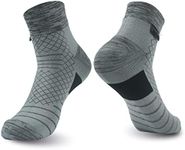Buying Guide for the Best Waterproof Socks
Choosing the right waterproof socks can make a big difference in your comfort and performance during outdoor activities like hiking, cycling, fishing, or even just walking in wet conditions. The main goal is to keep your feet dry and comfortable, but there are several features to consider to ensure you get the best fit for your needs. Understanding the key specifications will help you make an informed decision and avoid common pitfalls like sweaty feet, poor fit, or lack of durability.Waterproofing TechnologyWaterproofing technology refers to the method and materials used to keep water out of the socks. This is important because it determines how well your feet will stay dry in wet conditions. Some socks use a membrane layer sandwiched between fabrics, while others use special coatings. Generally, socks with a dedicated waterproof membrane offer better protection but may be less breathable. If you expect to be in very wet environments or standing in water, look for socks with a high-quality membrane. For lighter rain or occasional splashes, a water-resistant coating may be enough.
BreathabilityBreathability is how well the socks allow moisture and heat from your feet to escape. This is crucial because even if water can't get in, sweat can build up inside, making your feet damp and uncomfortable. Breathability is often balanced with waterproofing; more waterproof socks can sometimes be less breathable. If you plan to be active or wear the socks for long periods, prioritize breathability to avoid sweaty feet. For short-term use or less strenuous activities, you can focus more on waterproofing.
Material CompositionMaterial composition refers to the types of fabrics used in the socks, such as merino wool, nylon, polyester, or elastane. This affects comfort, warmth, and durability. Merino wool blends are great for warmth and odor control, while synthetic fibers like nylon add strength and quick-drying properties. If you need socks for cold weather, look for a higher percentage of wool. For warmer climates or high-intensity activities, lighter synthetic blends may be better.
Thickness and CushioningThickness and cushioning determine how much padding and insulation the socks provide. Thicker socks offer more warmth and comfort, which is ideal for cold or rough conditions. Thinner socks are better for warmer weather or when you need a closer fit in your shoes. Consider your activity: for hiking or long walks, extra cushioning can help prevent blisters and fatigue. For cycling or running, a thinner sock may fit better in snug shoes.
Fit and SizingFit and sizing are about how well the socks conform to your feet. A good fit prevents bunching, slipping, and blisters. Waterproof socks can feel less stretchy than regular socks, so it's important to check sizing charts and, if possible, try them on. If you are between sizes, some people prefer to size up for comfort, but too loose a fit can reduce effectiveness. Think about the shoes you'll wear and whether you need a snug or relaxed fit.
LengthLength refers to how high the socks go up your leg, such as ankle, crew, or knee-high. This matters for both protection and comfort. Ankle socks are best for low-cut shoes and light splashes, while crew or knee-high socks offer more coverage for deep puddles, tall boots, or cold weather. Choose the length based on your activity and the conditions you expect to face.
DurabilityDurability is how well the socks hold up to repeated use and washing. Waterproof socks can be more delicate due to their special layers, so reinforced toes and heels or abrasion-resistant fabrics are a plus. If you plan to use them frequently or in tough conditions, look for socks with extra durability features. For occasional use, standard construction may be sufficient.
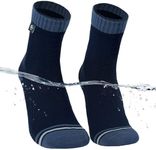
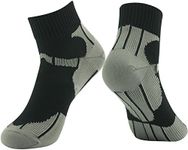



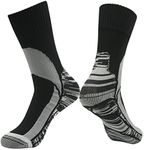




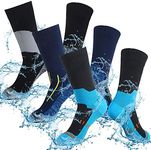


![The Wudhu Socks: Non-Leather, Waterproof, Breathable & Anti-Odor Socks for Ablution & Outdoor Activities [Unisex] (Small, Jet Black)](https://images-proxy.bestreviews.guide/INKfWxo9QbTNfMPCdMa2QmWodPY=/0x150/https://m.media-amazon.com/images/I/41DME8y+EXL._AC_CX679_.jpg)
